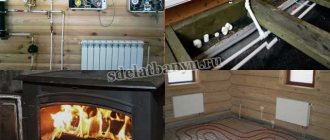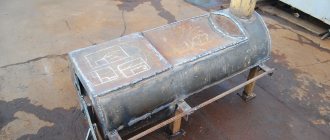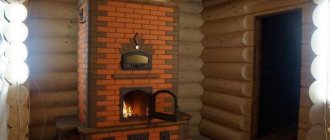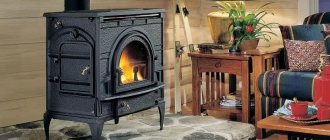Maintaining a comfortable temperature in a bathhouse is not an easy task. Especially if the size of the premises is quite large and the climatic conditions in the region are quite harsh. Therefore, any ways to ensure a stable microclimate in the bathhouse arouse great interest among the owners and immediately become in demand. One of the most effective options is the organization of heating.
5/5 — (1 vote)
The sauna is used periodically, and after a few days of inactivity it can become too cold. It will take a very long time to warm it up. In addition, water in the boiler or pipes may freeze, and this is already dangerous - pipes or shut-off valves may rupture. Therefore, maintaining a stable positive temperature can preserve engineering systems and save time for heating. Let's take a closer look at this issue.
Heating by furnaces with heat exchangers
Stoves with heat exchangers are an alternative option to conventional heaters, which provide space heating, hot water supply and steam generation.
Heating in a bathhouse from a stove heat exchanger can be organized both for the main premises - steam room and washing room, and for auxiliary ones - dressing room, relaxation room, billiard room, shower room, swimming pool.
At the design stage of heating equipment with a heat exchanger, the following data is taken into account:
- dimensions of the building and area of premises;
- design features of the furnace;
- weight of heating equipment;
- number of heat exchangers;
- coolant volume;
- length and diameter of the chimney pipe.
The following options for connecting heating equipment using pipes are possible:
- to the expansion tank for hot water supply in the washing compartment;
- to heating radiators installed in functional rooms;
- to hot water supply and water heating system in the main premises of the bathhouse and residential building.
Heating stoves are equipped with internal and external heat exchangers. The internal element is located in the firebox, the external element is located around the chimney pipe.
Algorithm for constructing a metal furnace
The foundation for the stove should be made of non-combustible material. Fireclay brick, sheet metal or concrete are suitable. To make the base aesthetically pleasing, it can be tiled. The firebox door is directed to the opposite corner. The floors are made of fireproof material. If wood is used, it is covered with a metal sheet 60 cm wide.
To create a classic interior design in a bathhouse, a metal stove can be lined with brick. In addition to being beautiful, this move will prevent burns. To properly build a chimney and determine at what distance from the walls the heater should be placed, be sure to study the instructions.
How to make heating in a bathhouse
Heating in the bathhouse is necessary to provide convenience.
One type of heating is automatic. Separate heating can be provided by electric convectors or electric boilers, as well as gas boilers. All of them can work offline. You can set it so that the room temperature is slightly above zero. This will prevent water from draining from the toilet tank, pipes, or electric boiler.
There is a minus in this system. Since it is autonomous, you may not notice that a failure has occurred and the temperature may drop below zero. Therefore, you need to install a temperature sensor with a signal.
How to install heating in a bathhouse from home
You can install both gas or electric boilers and stone or metal stoves. But these are all quite complex structures.
To heat a bathhouse from home, you can lay a heating main there. Install radiators in the house. Such a system will operate from heating in the house.
Heating a bathhouse from a sauna stove
The easiest heating method to manufacture, operate and maintain is heating a bathhouse from a sauna stove. The stove is installed directly in the steam room, and the firebox is installed in the dressing room.
Brick kilns maintain temperature for a very long time, but they must be heated for at least 5 hours. And it takes even longer to heat a bathhouse in winter.
High cost is another disadvantage. It is very difficult to build such a stove yourself. The help of an experienced stove maker is needed.
Heating the dressing room from a sauna stove
In most cases, a classic sauna is heated with one heat source. The stove is installed in the steam room so that all rooms can be heated. A tank of water is placed near the washing room.
It is very important that each element of the stove is made of refractory material. Therefore, it must be built from bricks
Such an oven will take up a lot of space and be large.
The ideal option would be a stove with a tank and an open heater. The firebox is equipped with a register, the lower edge of which is located 50 cm above the register. It will prevent premature boiling of water.
Is it possible to make heating from a tank?
To install a heating system from a tank, you need to know its operating specifics and operating rules. It is necessary to take into account the volume of the room and power consumption.
There are mounted and built-in tanks. There are also set-up tanks - a container of water is placed on top of a heated oven.
Comment! You can use the already created heat: a tank is hung on the chimney, the water is heated, and the temperature there can reach 500 degrees.
These methods do not supply hot water to the shower. Remote water tanks can do this. The heat exchanger is placed in the furnace, and a tank is hung next to it or in the attic. The system is connected by pipes through which water will flow. Thanks to the heat exchanger, it is heated and supplied to the shower through the tank. This heating system is simple and effective.
Overhead tanks are sealed containers with a lid and a tap for draining water. Attached to the wall using metal hooks. Made from stainless steel.
Attached water tank - an inclined pipe sealed at the end is welded into the furnace. The other end is at the bottom of the tank. Cold water rises through an inclined pipe, where it is heated to a boil. Hot air bubbles transfer heat.
How to make heating in a log bath
Three types of heating are installed in wooden houses: water, electric and air. Each has pros and cons.
The most popular type of log heating is water.
Pros:
- Economical.
- High heat capacity.
Minuses:
- Difficult to install.
- The need to constantly monitor the heat generator.
- In winter, be sure to drain the water from the heating system.
Such heating systems are:
- with bottom or top wiring;
- passing or dead-end;
- single-pipe or double-pipe;
- vertical and horizontal;
- with a pump or natural movement of water.
Two-pipe systems are less aesthetically pleasing than single-pipe systems.
Electric heating has several advantages:
- The heat supply level is easily adjusted.
- Small dimensions of heating devices.
- The heating is environmentally friendly and silent.
Air heating has only one advantage - high penetrating power.
But there are many more disadvantages:
- large stoves and fireplaces;
- very low heat transfer;
- uneven distribution of air in the room;
- expensive heating systems.
Before installing systems, you should weigh the advantages and disadvantages and possibly consult with a specialist in the industry.
Heating in a bathhouse is the most important thing that needs to be paid attention to during construction. The bathhouse is one of the best relaxation places where you can have a pleasant time with family or friends. If it is warm and cozy there, then you will rest in body and soul
If it is warm and cozy there, then you will relax your soul and body.
Criterias of choice
The main indicators that must be taken into account when choosing a stove are the following:
- mechanism of action;
- manufacturing materials;
- fuel.
Baths can be heated using permanent or temporary (periodic) stoves. The first ones need to be kept burning the entire time the steam room is in use. For the second, preliminary high-quality heating is enough.
The range of materials from which a heater can be made now includes a large number of traditional and new technological elements.
The best stoves are made of steel and brick.
Brick structures
The leaders in demand are heaters made of periodic bricks. Continuous combustion heaters are also used to provide heating for saunas. but much less often.
Brick kilns of intermittent operation have both an advantage - they maintain a high temperature in the room for a long time, and a disadvantage - they need to be warmed up for at least 5 hours. In winter this takes even longer. Therefore, if bathing procedures are planned for the evening, then you need to start heating in the afternoon. After this, you can steam and not be distracted by other things, the heating will work without outside interference.
There is another disadvantage of such models - high cost. It is quite difficult to make such a heater yourself. To get a truly functional stove, you need an experienced stove maker. And his work is highly paid. The high cost of the heating structure can also be explained by the fact that it is necessary to lay a powerful foundation that will support a heavy brick heater.
Metal heat sources
Metal furnaces are characterized by the principle of constant operation. A stove with thin steel walls does not retain heat for long, which can be attributed to its disadvantages. And the advantage of a metal sauna stove is that it will take much less time to warm up the room.
In winter, this will take no more than 2 hours. It is better to organize heating using a steel heater in a small bathhouse. You can install the stove yourself.
Heating by stove-stove
For small baths, a traditional heater remains a viable heating option. In this case, it is enough to purchase or manufacture a heating unit of the required power.
Calculation of equipment power is determined by the formula: 1 kW of power per 1 sq. m of premises. To ensure a comfortable stay for visitors in the steam room, a thermal power reserve of 35 to 55% is additionally taken into account.
The popularity of the heating heater is explained by the following advantages:
- ease of installation and maintenance;
- accessibility of operation;
- using available fuel.
When giving preference to a sauna stove, do not forget about some of the disadvantages of the device:
- impressive dimensions and weight;
- inability to automate the process of heating rooms;
- high fire hazard;
- formation of fuel combustion products.
Modern heaters operate on wood, electricity, liquid and gaseous fuel. The choice of the appropriate option depends on the financial capabilities and technical capabilities of the equipment.
To ensure effective heating of the room, heating the bath from the stove in the steam room is done as follows: the firebox is placed in the dressing room, the heater is in the steam room, and the tank with warm water is in the washing compartment.
Selection of equipment for heating a bath
Sauna stove design
A modern stove for baths and heating can be of several types. But regardless of this, the structure must perform its main functions - heating the steam room and the coolant in the heating system.
There are several possibilities to implement this system in practice. If there is already a brick stove in the bathhouse, you can modify it. To do this you will need the following:
- Heat exchanger adapted to the firebox. Most often this is a home-made design, made to order according to the calculated dimensions. For this, heat-resistant steel with a thickness of at least 2 mm is used;
- Gas-burner. Its dimensions must be adapted to the dimensions of the combustion chamber of the sauna and heating stove. Otherwise, you will have to rebuild the firebox design.
It is best to choose models with flame modulation, as they can smoothly change the operating power, thereby regulating the degree of heating of the heater and coolant.
Gas-burner
To fully heat the attic of a bathhouse or the second floor of a building, it is recommended to purchase a factory-made gas boiler with a heat exchange device. Such models are characterized by reliable operation, high efficiency and safety.
Before installing gas heating in the bathhouse, the boiler power is pre-calculated. Manufacturers usually indicate the maximum and minimum volume of the steam room for each model. However, in addition to this, it is necessary to install water heating in the dressing room and other rooms. Therefore, in addition to the rated power, the area of the entire bath should be taken into account. Given good thermal insulation, you can use the formula:
W=(Qb-Qp)*41
Where W is additional power, W, Qb is the total volume of the bath, m³, Qп is the volume of the steam room, m³.
As an example, let’s calculate the additional power of a combined furnace for heating and steam room. The total volume of the building is 162 m³. The same figure for the steam room is 24 m³. Then the additional power required will be as follows:
W=(162-24)*41=5658 W or 6 kW.
In addition, when installing gas heating for a bath, you need to take into account the cost of the equipment. It all depends on the chosen circuit, power and budget.
| Model | power, kWt | Cost, rub. |
| Gas burner Sakhalin-2 | 26 | 12000 |
| Ermak gas stove | 12 | 20160 |
| DHW tank, 80 l. | 7515 | |
| Electric heater Helo LUMI 90 ST | 9 | 22350 |
For winter heating of the bathhouse, it is recommended to install a full-fledged heating system. This is especially true for regions with low temperatures in winter. But in addition to this, the specifics of installing the heating system are taken into account.
Gas heating
The implementation of such a heating system has several options.
- Firstly, as I wrote above, it is possible to install a “classic” heater, in which a gas burner will be used instead of firewood.
- Secondly, you can use a standard gas boiler (the same as in residential buildings). But in this case, you will have to take care of the equipment of heating systems (installation of heating radiators, laying pipes, connecting a gas-carrying pipe to the bathhouse or a cylinder connection system).
- Thirdly, there is the possibility of installing heating from the house. In essence, this is the same option as the previous one, but with its own characteristics and disadvantages. A separate heating main is laid from the boiler used to heat the house to the bathhouse. This option is very convenient if your steam room is adjacent to the house or is very close to it.
Gas heating baths
If the distance to the bathhouse is relatively large, then in order to use this system in winter it is necessary to bury the heating main below the freezing level of the soil and insulate it well. This will prevent the possibility of defrosting and help reduce heat loss.
True, the undoubted advantage of this option is the complete elimination of the problem of maintaining a constant positive temperature in the bathhouse. In addition, you can do all the necessary work (if you have a certain skill) with your own hands.
One or two pipe heating
As for the selection of a single-pipe or two-pipe heating system, the superiority of the first is considered to be the ideal pressure, as well as the rate of movement of water.
However, in heating radiators that are located away from the boiler, the temperature will be much lower, and it will be necessary to install extra sections on equipment intended for heating. Both types of systems can be easily installed with your own hands.
Vodyanoye
Water heating is rightfully considered one of the most convenient and effective methods of heating. In such a situation, there are also several options for manufacturing a system, which in any case will be powered from a furnace with a water circuit.
Fortunately, today in specialized stores you can easily select stoves that are ready for installation, equipped with a heat exchanger. This greatly simplifies the task of any builder of his own bathhouse. And now directly about the options.
Water heated floors
- External heating. It is done very simply and, in fact, is arranged in the same way as a brownie. Pipes located along the walls are connected to the furnace. Depending on the area of your bathhouse, a certain number of heating radiators are connected to the pipes. Hot water passing through them heats the structure and, when cooled, returns back to the boiler.
- Water heated floor. The principle of its operation is the same as in the first option. The only difference is that the pipes are hidden in the floor, which was previously insulated (I wrote about insulating floors in a bathhouse in more detail in other articles). This design is considered non-separable (although, of course, there would be a desire to break everything), and therefore requires a very careful approach to the procedure for its manufacture. In this case, I would recommend seeking help from specialists.
https://youtube.com/watch?v=GO5dAde3rQA
Recommendations when choosing a heating system
All systems can be divided into two types of heating:
- equipment with forced circulation;
- equipment with natural circulation.
With forced circulation, the coolant moves thanks to the pump. It maintains the required temperature and pressure in the system. It requires electricity to operate.
Natural circulation includes the boiler, batteries, expansion tank and pipes. We need competent pipe routing and correct calculation of their slope. The disadvantage is that the expansion tank must be at the highest point.
Homemade boiler for a bath
You can build a boiler for heating a bathhouse with your own hands. You need a pipe of a certain diameter, a welding machine and a grinder.
You can do . For this, it is very convenient to use sections of thick-walled pipe. The best option is a piece with a diameter of 51 cm and a length of 100 cm. Such a boiler, even in a very cold winter, can heat not only the steam room itself, but also other rooms.
Prepare the following tools for work:
- electric welding machine;
- “grinder” with metal circles;
- pipe of suitable length and diameter.
The selected section of thick-walled pipe will serve as the body of the future boiler. Inside the housing, 3 supports should be welded parallel to the ground at 3 different levels. These supports are made from ordinary reinforcement bars 30 cm long and 14 mm in diameter.
The lower support will make it possible to install the bottom of the heating unit. The height of the second support is selected in accordance with the size of the blower door installed in the boiler. The third support will be installed at a distance of about 20 cm from the top of the unit base.
To construct the bottom of the boiler, a solid metal circle with a thickness of at least 4 mm is used. Grate bars can be made from a metal circle with slots. Choose a circle as thick as possible, then the lid can also be used as a support for stones. The lid is made of a metal circle with a thickness of at least 5 mm. A hole should be made in the cover, which will be used to attach the adapter ring of the chimney pipe.
The system for placing supports under the partitions implies their location one above the other. Stove and blower doors are installed in the hole for the box, which must be cut in the side of the pipe from the very bottom.
The depth of the box should be selected in accordance with the thickness of the wall that will be used to make the boiler firebox. A partition installed inside the box is necessary to separate the combustion and ash compartments. The level of this partition must coincide with the grate partition installed in the inside of the boiler.
The installation procedure is as follows. First, the box is welded, after which the bottom, grate and top cover are inserted into the boiler body
When performing work indoors, you need to pay attention to the fact that the box passing through the wall goes into the furnace room or outside, and not into the dressing room
At the next stage, a chimney is installed and stones are placed on the top cover of the boiler. The boiler is directly installed on a special foundation. you can organize such heating with your own hands.
Installation on a wooden floor
Options
There are three options for installing a heat-resistant base:
- a metal sheet;
- brick;
- natural or artificial stone;
- ceramic or porcelain tiles. The minimum size of protection should be 40 cm.
Preparing the walls
As already mentioned, it is easier to decorate the walls with refractories than to take away useful space from the steam room. The most economical, but not the best option is to nail a sheet of metal to the wall on bars.
In general, we have the following options:
- attach the refractory sheet to the wall;
- plaster it (it is better to make the layer more than 2.5 cm);
- make a brick casing for the stove;
- lay it out with bricks instead of a wooden wall.
If the stove is located close to the wall, then you will need a two-layer mineralite with an air gap of 3 cm between these layers of ceramic bushings. It looks something like this: wooden wall - first layer of mineralite - bushings - second layer of mineralite.
When space allows, you can get by with one layer, but grommets are also used to attach it to a wooden wall.
Heat-resistant tiles or mirror stainless steel are sometimes placed on top of the mineralite. The latter perfectly reflects heat, but heats up itself, so it can be attached to any refractory material - mineral wool, ceramic fiber, superisol, etc.
Those who brought the firebox into the dressing room either put up a brick wall, or then cut out part of the timber. A space is left in the brick with a reserve for the combustion tunnel, where a heat insulator, for example, mineral wool, is subsequently placed. It is also used at the junction of brick and wooden walls. If you don’t want to replace the entire wall, make a portal - at least a meter wide.
Ceiling preparation and chimney installation
Often the cause of a fire is the section of the ceiling where the chimney is located. There are many errors associated with the passage of a chimney through ceilings.
The specific cause of the fire may be:
- pipe overheating;
- cracks in the pipe allowing sparks to pass through;
- shortcomings in the distance to combustible objects.
If you haven't thought about the position of the stove in advance, there may be a beam above it. In this case, part of the beam is cut out and fastened with jumpers to adjacent beams. The empty space above the center of the pipe passage must be at least 90 cm in diameter.
The chimney is installed from the pipe that comes out of the stove. In the case of a larger diameter monopipe, an adapter is put on the pipe. The first pipe passing through the steam room will be a monopipe
A gate is installed on it, then it continues again, but not to the end (this is very important!) of the overlap, because there they put a “start” on it - an adapter for a sandwich pipe that will pass through the ceilings
Pipe connections should not be in overlap areas.
It is important to know here that although sandwiches are the most common, they are a dangerous type of chimney. An analogue of sandwich pipes is ceramic or brick chimneys, but both options are heavier and more expensive
The outer side of the box can be wrapped with basalt cardboard to prevent it from touching the wood. The pipe is then laid on the roof through a hole larger in diameter than the pipe itself. Next, it is sealed with sealant, a master flush is put on and secured to the roof with self-tapping screws at intervals of 5 cm. Finally, a deflector or umbrella is installed.
Preparing the oven
Before installing the chimney, the stove should already be located in its designated place. It is recommended to heat it outside first
It is extremely important to do this, because... the first fire is usually accompanied by burnout of industrial heat-resistant paint
The oven may smoke a little and smell. This is a normal state for her. At the same time, you will find out whether it has any manufacturing defects.
New stones should also be tried out in the fresh air, not inside, because they can also sting the throat and eyes.
Strictly follow the step-by-step instructions for installing a metal stove.
Water and infrared floor installation
Gas boiler diagram.
A water heated floor is a pipe system located between the base of the floor and its subfloor. The pipes are laid in loops over the entire floor area, a separate circuit is made for each room, the flow of coolant is regulated by taps that are installed on each circuit. Coolant circulation is carried out by pumps. Boilers (wood, gas, electric) are used to heat the coolant. When installing a water floor with your own hands, you must take into account the possibility of heat leakage through the base of the floor; to prevent this from happening, the pipes are laid on a heat insulator with aluminum foil.
An infrared heated floor is a film with radiating elements or a heating mat made of carbon rods. In rooms with high humidity, which is what a bathhouse is, it is better to use heating mats. Infrared radiation from the floor heats surrounding objects, which transfer their energy to the air in the room.
This heating method is more efficient than convection heating, and therefore the energy consumption for heating is significantly lower than that of an electric convector. Installing an infrared floor with your own hands is easier than installing a water floor. Waterproofing is laid on a dry and clean base, then a substrate on which a system of heating mats is mounted. During installation, it is necessary to take into account all the nuances specified in the manufacturer’s instructions.
Convectors, heating a bathhouse from a residential building The easiest way to heat a bathhouse is to use electric convectors. To feel at home in the bathhouse, just connect the convector to the network. However, this heating method requires significant energy consumption. Gas convectors are more complex devices; for their operation, it is necessary to install a gas and air supply system into a special chamber where the gas is burned, and to ensure the removal of combustion products. It is not possible to install such heating with your own hands; specialists must work with gas equipment. The installation of these devices is justified in production facilities, warehouses or garages. They are not suitable for a home or bathhouse.
https://youtube.com/watch?v=v0vbA44F-Tc
If the home is heated with liquid energy, then the bathhouse can be easily connected to the heating system of the living space. Radiators are installed in the bathhouse and connected by pipes. The pipes are removed, insulated and laid in a trench; the depth of the trench should be below the freezing level of the soil. Next, we bring the pipes into the house and make a connection with the heating circuit. That is, another room appears near the house. But before you do such heating, you need to make sure that the boiler power is sufficient.
Principle of operation
The device is a pipeline with a coolant inside, which is powered by a sauna stove heated with wood or other fuel. The stove must be converted to heat underfloor heating.
After ignition, it warms up the system, full heating is achieved by the time the steam room is ready. Water circulates using an installed pump; it is included in the mixing unit. Warm pipes heat up the screed and flooring, which in turn transfers it to the room.
Electrical
And finally, let’s look at several ways to use electricity to heat a bathhouse. I’ll say right away: take care of the electrics in this case. Since the load on thermal electrical appliances is large, the quality of the electrical wiring should not be in doubt. Consider the total load, wire cross-section, wiring diagram and quality of electrical work.
Electric heating
Firstly, your room can be heated using an electric heater. True, in this case you will have to take care of heating the water in the shower in advance (for example, by installing a direct or indirect heating boiler). This type of heater does not require additional arrangement of the chimney and is considered environmentally friendly.
Secondly, the bathhouse (in particular the relaxation room) can be heated using electric convectors placed on the walls.
Well, thirdly, infrared film can come to your aid - the newest type of heater, which allows you to easily and quickly create warm floors both in the house and in the bathhouse. Detailed technology for installing heated floors is discussed in other articles.
Please note that the installation of heated floors is possible without the use of infrared film, but by laying electric heating cables. They are used both in underfloor heating systems and for heating water pipes.
It is quite possible to use infrared heaters as an additional source of heat. I hung it on the ceiling and forgot about it.
Infrared heaters
Using electricity to heat a bath undoubtedly has its advantages. You can safely use all the structural elements (heater, heated floor, boiler) at any time all year round. At the same time, you don’t have to worry about fuel or worry about pipes freezing. The only serious drawback can be considered the high energy consumption.
Foundation
There may be two options here.
First - the bathhouse floors have already been laid
The option, let’s say right away, is not very pleasant. How to solve the problem? First you need to approximately calculate the total weight of the stove along with the brickwork.
The weight of the stove can be found in the manufacturer’s passport or catalog
The weight of one red solid brick is ≈ 3.5 kg, the masonry will be half a brick. There is no longer a need, such a thickness will ensure both normal heat transfer and sufficient stability of the structure.
Red brick weight
Weight of a pallet with bricks
There are recommendations to do quarter masonry (put the brick on edge), but we would not recommend it. Firstly, laying on edge requires considerable experience. Secondly, the stability of the structure is unsatisfactory.
For reference. The dimensions of a standard single brick are 250×120×65 mm. For one cubic meter of masonry you need approximately 520 pieces with a mortar thickness of approximately one centimeter. To make calculations easier, you need to remember that for 1 m2 of half-brick masonry you need ≈ 53 bricks. Take with reserve, there will inevitably be waste.
Standard sizes of solid bricks
Find the location of the floor beam, you can find it by the floor nails. As a rule, during the construction of a bathhouse, timber is used under the flooring with a size of at least 100×100 mm; it can withstand up to 500 kg of weight. This is quite enough for a small metal stove; there is no need to reinforce the timber.
Photo of floor beams
Place a sheet of metal under the perimeter of the stove, it is advisable to make a thermal protection, strictly follow the rules of SNiP III-G.11-62.
SNiP
It is not recommended to use asbestos sheets as a thermal insulation material; today there are harmless materials made from pressed mineral wool on sale.
For brickwork you need to make waterproofing (for fireclay - no need, it is not afraid of moisture). For waterproofing, it is better to take two layers of ordinary transparent polyethylene film - it is much more beautiful than black roofing felt. The protruding film must then be carefully trimmed around the perimeter of the masonry. Do not be afraid that such a stove base raises doubts about its reliability. If the chimneys were brick, yes, even minor “wobbles” of the stove could cause big problems. In our version, the chimneys will be made of metal pipes. At the connection points and at the points where they exit outside, the structure is “floating” and is capable of compensating for small vibrations.
Types of chimneys for baths
Second option. The floors have not yet been laid
The best option is to make a stable foundation for the stove. And the presence of a foundation significantly expands the possible options for stoves both in weight and design features. How to make a foundation?
| Step, No. | Diagram or photo | Explanations |
| Step 1. | Foundation diagram | Mark the dimensions of the pit; along the perimeter it should be 10 cm larger than the dimensions of the stove. |
| Step 2. | Digging a hole for the foundation | Dig a hole 50÷60 centimeters deep; it is not worth it deeper for two reasons. Firstly, in a bathhouse the depth of freezing of the soil is much less than in an open space. Secondly, the stove is not a design that requires a strong, stable foundation. |
| Step 3. | Foundation diagram | Make a sand cushion at least 15 cm thick and compact it. It compensates for soil swelling, if such a fact occurs. |
| Step 4. | The foundation for the furnace is laid out from foundation blocks with dimensions 200x200x400, 200x300x400, 200x300x600. Masonry is carried out using cement-sand mortar gas silicate stove foundation (example) | For the furnace, you can install a simplified foundation made of concrete blocks, this is much faster and easier. Take concrete blocks of any size, the quantity depends on the size of the hole, place them on the cement mortar. Keep an eye on the horizontal position at all times. We do not recommend cutting blocks if their height exceeds the height of the floor. Firstly, it is quite difficult; you need a large diameter diamond disc. Secondly, the foundation protruding a few centimeters does not affect comfort in any way. |
At this point, the preparatory work is completed, and you can begin to directly install the stove with an external firebox.
Several alternative options
Despite the fact that the options described above are the most popular and considered optimal, I decided to briefly mention some alternatives. In fact, they are varieties of stove heating, but have their own characteristics.
For example, if you have such capabilities, then you can install a diesel fuel boiler in your bathhouse. But this option requires a separate room (diesel fuel does not smell much), and you need to think about fuel storage.
There are also pyrolysis heating boilers. The undoubted advantage of such a boiler can be considered a very long, almost complete combustion of fuel. The disadvantage is the high cost and difficulty of operation (for example, raw wood does not burn in it).
It is also possible to use long-term combustion boilers, capable of burning a separate batch of fuel for up to 5 days, maintaining the desired temperature. There are even options for high-quality graded coal. But this is rather an “industrial” option, which is not suitable for a good traditional bath.
This is where I will finish the review of methods for heating a bath. Which heating is better is up to you to decide, focusing on your needs and capabilities. The main thing is that the rooms are warm and comfortable. Thank you for reading to the end. Until next time, see you on the pages of other articles. Bye!
Wisdom Quote: There are no dark times, only dark people (Roland Romain).
Construction of a gas stove
Gas is an explosive fuel. If you plan to use gas, then the stove must be equipped with an automatic system that will shut off the fuel supply in the event of no flame.
When the house is connected to a central gas main, natural gas can serve as fuel for the heater. If the heating is individual, propane or butane will do.
Gas heating in the bathhouse at any time of the year is carried out in accordance with fire safety rules established for hazardous fuels.
Some useful tips for installing a sauna stove
Heating system installation diagram.
Since a bathhouse usually has three rooms: a dressing room, a steam room and a wash room, the best option when installing a stove with your own hands is the option in which the firebox is in the dressing room, the heater is in the steam room, and a container with heated water is in the wash room. Existing models with a side-mounted heater will provide just such a configuration of the heating elements of the stove.
When building walls in a bathhouse, flammable materials (wood, insulation) are very often used, so when installing a sauna stove with your own hands, one should not forget about fire safety. Fireproof material is laid between the walls and the stove. The stove is installed on a steel sheet with non-flammable thermal insulation, and if it is heated with wood, then the same thermally insulated sheet is required in front of the fire door. The pipe is discharged through a ceiling device made of sheet steel and having a hole of the appropriate diameter. The stove is installed before finishing work begins.
A steel heater warms up the room very quickly, but requires constant burning, since it has practically no ability to accumulate heat. The heat from this type of heater is intense; ventilation will be needed to create more comfortable conditions.
A sauna stove made of brick has a number of advantages. Thick brick walls accumulate heat, gradually releasing it to the room. The process of heating the bath takes a long time, but the heat lasts a long time and there is no need for continuous burning. Making a brick heater with your own hands is difficult even if you have some construction skills. It is better to entrust the masonry to a qualified stove builder, but you can make a foundation of reinforced concrete for the stove on your own.
Brick or metal
The choice of furnace material matters only from the point of view of individual preferences and conditions:
- Price. Based on the cost of the final product, purchasing a metal furnace will be cheaper than purchasing material and paying workers to build a brick furnace. If you do the masonry yourself, the final cost will decrease due to the deduction of payments to hired workers, which will significantly affect the price.
- Bath area. Metal stoves take up less space, so if the area is small, the choice is definitely in favor of a metal product.
- Difficult to install. A brick stove requires a separate foundation, which lengthens the installation period; a metal stove is installed on a lighter base. The wood-burning sauna stove is quite popular and is practical.
- Sometimes the decisive factor is a photo of a factory-made metal stove - the range of modern manufacturers is distinguished by functionality and attractive design.
Operating principle of the furnace
Let's talk a little about how the bathhouse heating system will transfer heat to the outside. If the heat radiation is at its maximum, you risk overheating or getting burned. Also, excess heat negatively affects the condition of the skin. To ensure comfortable conditions in the bathhouse, the stove must release heat using the principle of convection. Hot air comes from the oven and cooled air is supplied.
To achieve this result, the temperature of the furnace walls will be lower. But build the walls of the bathhouse from materials that will reflect infrared rays as much as possible. Heat accumulates well in the wall and in the stone backfill. In order for the stove to give off heat for as long as possible, build its walls thicker.
Heating a bathhouse in winter with warm floors
Currently, when heating the floor in a steam room, expanded clay, felt, and other materials are often used. The insulation layer is placed between the joists or layers of building concrete.
The insulator should be approximately 15 cm wide. Moreover, it makes sense to mention that due to the use of expanded clay insulation, it is possible to additionally install a hood in the bathhouse.
Important! In order to install electric heated floors in a steam room, a layer of heat-insulating material must be fixed onto a flat and absolutely clean floor.
Then you need to install a special metal mesh that will separate the liner from the coating. Next, guide rails are installed along which the electrical cable runs, and only then will you need to connect it to the thermostat.
Combined heating system for bathhouse and home
If a residential building is connected to a central heating system, it is recommended to install auxiliary equipment for heating the bath.
Thus, the heating main from the house to the bathhouse is a practical and economical way to heat residential and functional premises.
In this case, the connection of the bathhouse to the heating system from the house is carried out through insulated pipes laid underground. In the bathhouse they are connected to heating radiators or convectors installed in all functional rooms. A sauna stove is used to heat the steam room and washing compartment.
At a short distance from the heating equipment installed in the house to the bathhouse, heat losses in such a system are insignificant.
In this case, the heating main of a residential building can be used for additional heating of the bathhouse, helping to maintain a comfortable temperature regime in winter. This will prevent possible freezing of sewer and water pipes and buildings.
The choice of a suitable heating system depends on the design features of the bathhouse and the financial capabilities of the owner.
Some owners prefer traditional electric or wood-burning heaters, which provide soft and even heating of the premises. Others choose combination systems or advanced heating technologies.
But if you know how to make heating in a bathhouse, following the rules and recommendations, the operation of the building is possible throughout the year under any climatic conditions.
How to warm up a steam room during the cool season
Since, according to the conditions of the problem, there is usually no central heating in the bathhouse, we will analyze all other options. For example, there will be no difficulties with heat in a small steam room, which is completely heated by a stove installed in the steam room.
If the internal buildings are quite large, then the power of the stove and direct contact with it are not enough. And look, here are the options for different heating of the steam room in winter.
Reference! The best are steel and brick stoves.
Furnace air heating
Let us briefly consider this type of heating (warming up) of a bath. In fact, this option is considered the most common and most convenient. It is ideal for small spaces used directly for bathing procedures.
A good heater will be able to easily heat the entire bathhouse, and will not require the installation of an additional heat source and additional cash costs. Previously, to equip a good sauna stove, you had to find a professional mason or show good imagination to make it using scrap materials (what kind of stoves were invented).
Now everything is much simpler. You can easily purchase a ready-made product in almost any specialized store. Moreover, the installation of such heaters is quite simple and does not require any specific conditions.
The only thing you should pay special attention to when purchasing it is power (usually indicated in the product passport)
It is recommended to proceed from the calculation of 1 kW of power per 1 square meter of heated room. At the same time, in order to achieve maximum comfort and use the bathhouse at extreme drops in outside temperatures, it is worth taking into account when purchasing a power reserve, up to 30-50% exceeding your calculations. Here's an article about more detailed choices.
This type of heating also has another positive side. Most stoves of this type are heated with wood, which forms a unique psychological picture and allows true bathhouse lovers to preserve the tradition laid down by our ancestors.
By the way, the well-known company Teplodar recently released a new model of stove-fireplace called Siesta. She quickly gained authority among her “bathhouse brethren.” And this is no coincidence, since it is heated from the adjacent room, thereby simultaneously heating both the steam room and the relaxation room. Agree, it’s very convenient.
Naturally, there are options for heaters that use electricity, gas and even liquid fuel for heating. Well, here, I’ll tell you, everything is an acquired taste and depends on your capabilities and preferences.
https://youtube.com/watch?v=Waxg6VSKkXQ
Construction of a brick stove
The main problem that arises when installing a brick heater is the massiveness of the structure. This requires the construction of a reinforced concrete foundation. For those who do not have experience in building sauna stoves with their own hands, the following tips may be useful.
If you put a thick layer of mortar between the brick joints, then under the influence of high temperatures it will begin to collapse and the heater will become leaky. On the contrary, a thin layer of mortar between the brick joints will negatively affect the life of the structure.
Each vertical layer of masonry must be covered with a top brick. It is advisable to make the ceilings in half a brick.
There are other nuances. So, if cut bricks are used, then the whole side should be turned inside the furnace. To ensure uniform linear expansion, cast iron elements are installed with a gap. To secure the upper part of the stove door, it is better to use a metal clamp.











